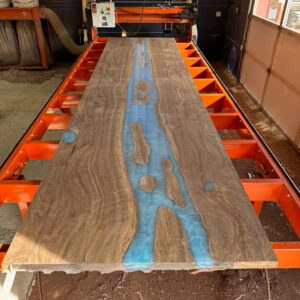
Slab flattening can take your woodworking to the next level. This essential process turns rough-cut lumber into stunning, functional pieces like tables and countertops by creating a smooth, stable surface. Slab flattening is even more critical for natural or live-edge wood, as these pieces often have warps and uneven areas.
A flat surface strengthens your project and ensures a cleaner, more professional finish. Even minor imperfections can throw off alignment and affect the final look of your project. Keep reading for woodworking techniques and tips to improve your craft through slab flattening.
Advantages of Slab Flattening
This process can improve the quality of your projects. Consider the following advantages.
Improved Stability
Furniture like tables and benches need a flat surface to support weight. Uneven slabs can weaken joints and structures over time, and slab flattening can prevent this.
Aesthetic Appeal and Precision
Flattening brings out the natural beauty of wood grain and patterns. Smooth, level surfaces make it easier to apply finishes, oils, or stains evenly, enhancing the wood’s natural features. Flattened slabs provide a clean, professional look that reflects quality craftsmanship.
Easier Joinery and Assembly
Flattening makes joinery easier by allowing for better alignment of slabs and supports. This ensures tighter, cleaner joints and accurate alignment for pieces like tables or countertops.
Improved Workflow and Efficiency
Flat slabs make woodworking projects easier. When surfaces are level from the start, you avoid constant adjustments, which helps you work more efficiently.
Using flat slabs reduces mistakes and the need for rework. This speeds up project completion and allows you to tackle new projects without delays.
Slab Flattening Techniques for Woodworkers
Depending on your equipment and skill level, several techniques exist to flatten a wood slab. Here are three common methods.
1. Using a Router Sled
A router sled effectively handles large slabs and offers precise control during flattening. Here’s a condensed version of how this works.
- Clamp the slab to a stable surface
- Install the router bit and set the depth
- Place the sled on the slab, ensuring it’s level
- Turn on the router and move it back and forth, checking for flatness
- Clean up edges with the router as needed
2. Flattening with a Drum Sander
A drum sander has a large sanding drum that gradually flattens the slab. It’s ideal for removing minor imperfections and achieving a perfectly smooth surface. Here’s how it’s done;
- Clamp the slab securely on a stable surface
- Use a straight edge to find high spots on the slab
- Adjust the height of the drum sander, starting with coarse grit sandpaper
- Run the slab back and forth through the drum sander
- Change to finer grit sandpaper for a smoother finish
- Check for flatness and make adjustments
3. Using a Planer and Jointer Combination
A planer reduces a board’s thickness and creates smooth, flat surfaces on both sides. A jointer flattens one face of a board and creates a straight edge along one side.
To use a planer, inspect the board for defects and set the thickness (starting around 1/16 inch). Feed the board slowly, supporting longer boards, and make multiple passes, checking for even thickness.
For the jointer, inspect the boards for warp and trim any rough edges. Set the fence to 90 degrees with a depth of 1/16 inch. Run the flat side steadily through the jointer, then align one edge with the fence to create a smooth, straight edge.
Choosing the Right Slab Flattening Tools
Using proper tools can make or break your project. Consider the following options.
Router Sled
Great for DIY projects with adjustable settings. It’s versatile and commonly used by hobbyists and professionals.
Drum Sander
This high-speed tool is ideal for large projects or professional workshops. It’s best for finer flattening and final sanding on projects.
Planer and Jointer
These tools are suitable for small slabs and ensure an accurate, flat surface. Many woodworkers combine these tools to achieve balanced results.
Tips for Effective Slab Flattening in Woodworking
Flattening slabs can be challenging. But you can achieve professional results with the right approach. Here are some tips:
Check Moisture Levels Before Flattening
Wood moisture can affect stability. Ensure the slab is properly dried before flattening to avoid warping or cracking.
Secure the Slab Firmly
During flattening, secure the slab to your workbench to prevent shifting. This ensures consistent cuts and reduces the risk of an uneven surface.
Take Your Time
Flattening requires precision, so work slowly and remove small layers with each pass. Rushing can result in gouges or inconsistencies in the wood surface.
Test for Flatness Regularly
Use a straightedge to check for high spots, and adjust your technique accordingly. This helps ensure evenness across the slab and catches issues early.
Plan for Final Sanding
After flattening, sand the surface to remove any tool marks. This final step gives your project a smooth, polished appearance, ready for finishing.
Slab Flattening and Its Role in Furniture Making
Slab flattening is crucial for stability and quality in woodworking. An uneven tabletop not only looks unprofessional but also lacks stability.
Although slab flattening can be a DIY job, it requires special tools and skills. If you’re not experienced, hiring a professional might be a better choice for the best results.
Flattening supports the use of custom live-edge pieces. For woodworkers who love the natural look, this technique keeps the slab’s organic shape while adding strength and functionality.
Woodworking Project Enhancements
With a flat slab, woodworkers can confidently add details and joinery. This technique works for everything, including:
- Basic tabletops
- Custom shelving
- Cabinetry
- Live-edge bar tops
- Countertops
Flattened slabs make adding features like metal or wood inlays easier, which need flat surfaces for proper alignment.
The Importance of Slab Flattening
Slab flattening is important in woodworking for stability, precision, and overall quality. Whether making a rustic live-edge table or a modern countertop, starting with a flat slab helps ensure a professional and durable finish. Using the right slab flattening techniques and tools improves the look and lifespan of your projects.
At Les Bois Milling, we connect quality lumber with skilled craftsmen to create satisfied customers. We’re dedicated to bringing local wood into the homes and businesses of the City of Trees. If you’re a craftsman or simply want something special, contact us today, we’re here to help!

